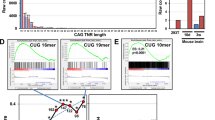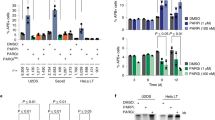Abstract
Expansion of CAG/CTG trinucleotide repeats is associated with certain familial neurological disorders, including Huntington's disease. Increasing evidence suggests that formation of a stable DNA hairpin within CAG/CTG repeats during DNA metabolism contributes to their expansion. However, the molecular mechanism(s) by which cells remove CAG/CTG hairpins remain unknown. Here we demonstrate that human cell extracts can catalyze error-free repair of CAG/CTG hairpins in a nick-directed manner. The repair system specifically targets CAG/CTG tracts for incisions in the nicked DNA strand, followed by DNA resynthesis using the continuous strand as a template, thereby ensuring CAG/CTG stability. Proliferating cell nuclear antigen (PCNA) is required for the incision step of the hairpin removal, which uses distinct endonuclease activities for individual CAG/CTG hairpins depending on their strand locations and/or secondary structures. We discuss the implications of these data for understanding the etiology of neurological diseases and trinucleotide repeat instability.
This is a preview of subscription content, access via your institution
Access options
Subscribe to this journal
Receive 12 print issues and online access
$189.00 per year
only $15.75 per issue
Buy this article
- Purchase on Springer Link
- Instant access to full article PDF
Prices may be subject to local taxes which are calculated during checkout






Similar content being viewed by others
References
Mirkin, S.M. Expandable DNA repeats and human disease. Nature 447, 932–940 (2007).
Pearson, C.E., Nichol Edamura, K. & Cleary, J.D. Repeat instability: mechanisms of dynamic mutations. Nat. Rev. Genet. 6, 729–742 (2005).
Gordenin, D.A., Kunkel, T.A. & Resnick, M.A. Repeat expansion–all in a flap? Nat. Genet. 16, 116–118 (1997).
Kang, S., Jaworski, A., Ohshima, K. & Wells, R.D. Expansion and deletion of CTG repeats from human disease genes are determined by the direction of replication in E. coli. Nat. Genet. 10, 213–218 (1995).
Miret, J.J., Pessoa-Brandao, L. & Lahue, R.S. Orientation-dependent and sequence-specific expansions of CTG/CAG trinucleotide repeats in Saccharomyces cerevisiae. Proc. Natl. Acad. Sci. USA 95, 12438–12443 (1998).
Richards, R.I. & Sutherland, G.R. Simple repeat DNA is not replicated simply. Nat. Genet. 6, 114–116 (1994).
Gacy, A.M., Goellner, G., Juranic, N., Macura, S. & McMurray, C.T. Trinucleotide repeats that expand in human disease form hairpin structures in vitro. Cell 81, 533–540 (1995).
Moore, H., Greenwell, P.W., Liu, C.P., Arnheim, N. & Petes, T.D. Triplet repeats form secondary structures that escape DNA repair in yeast. Proc. Natl. Acad. Sci. USA 96, 1504–1509 (1999).
Petruska, J., Arnheim, N. & Goodman, M.F. Stability of intrastrand hairpin structures formed by the CAG/CTG class of DNA triplet repeats associated with neurological diseases. Nucleic Acids Res. 24, 1992–1998 (1996).
Panigrahi, G.B., Lau, R., Montgomery, S.E., Leonard, M.R. & Pearson, C.E. Slipped (CTG)•(CAG) repeats can be correctly repaired, escape repair or undergo error-prone repair. Nat. Struct. Mol. Biol. 12, 654–662 (2005).
Corrette-Bennett, S.E., Parker, B.O., Mohlman, N.L. & Lahue, R.S. Correction of large mispaired DNA loops by extracts of Saccharomyces cerevisiae. J. Biol. Chem. 274, 17605–17611 (1999).
Littman, S.J., Fang, W.H. & Modrich, P. Repair of large insertion/deletion heterologies in human nuclear extracts is directed by a 5′ single-strand break and is independent of the mismatch repair system. J. Biol. Chem. 274, 7474–7481 (1999).
McCulloch, S.D., Gu, L. & Li, G.M. Nick-dependent and -independent processing of large DNA loops in human cells. J. Biol. Chem. 278, 50803–50809 (2003).
Zhang, Y. et al. Reconstitution of 5′-directed human mismatch repair in a purified system. Cell 122, 693–705 (2005).
Hartenstine, M.J., Goodman, M.F. & Petruska, J. Base stacking and even/odd behavior of hairpin loops in DNA triplet repeat slippage and expansion with DNA polymerase. J. Biol. Chem. 275, 18382–18390 (2000).
Bhattacharyya, S. & Lahue, R.S. Srs2 helicase of Saccharomyces cerevisiae selectively unwinds triplet repeat DNA. J. Biol. Chem. 280, 33311–33317 (2005).
Easteal, S., McLeod, N. & Reed, K. DNA Profiling: Principles, Pitfalls and Potential (Harwood Academic, Langhorne, PA, 1993).
Umar, A. et al. Requirement for PCNA in DNA mismatch repair at a step preceding DNA resynthesis. Cell 87, 65–73 (1996).
Guo, S. et al. Differential requirement for proliferating cell nuclear antigen in 5′ and 3′ nick-directed excision in human mismatch repair. J. Biol. Chem. 279, 16912–16917 (2004).
Chen, J., Jackson, P.K., Kirschner, M.W. & Dutta, A. Separate domains of p21 involved in the inhibition of Cdk kinase and PCNA. Nature 374, 386–388 (1995).
Friedberg, E.C. et al. DNA Repair and Mutagenesis (ASM, Washington DC, 2006).
Sancar, A., Lindsey-Boltz, L.A., Unsal-Kacmaz, K. & Linn, S. Molecular mechanisms of mammalian DNA repair and the DNA damage checkpoints. Annu. Rev. Biochem. 73, 39–85 (2004).
Wood, R.D., Mitchell, M., Sgouros, J. & Lindahl, T. Human DNA repair genes. Science 291, 1284–1289 (2001).
Oussatcheva, E.A., Hashem, V.I., Zou, Y., Sinden, R.R. & Potaman, V.N. Involvement of the nucleotide excision repair protein UvrA in instability of CAG•CTG repeat sequences in Escherichia coli. J. Biol. Chem. 276, 30878–30884 (2001).
Parniewski, P., Bacolla, A., Jaworski, A. & Wells, R.D. Nucleotide excision repair affects the stability of long transcribed (CTG*CAG) tracts in an orientation-dependent manner in Escherichia coli. Nucleic Acids Res. 27, 616–623 (1999).
Lin, Y. & Wilson, J.H. Transcription-induced CAG repeat contraction in human cells is mediated in part by transcription-coupled nucleotide excision repair. Mol. Cell. Biol. 27, 6209–6217 (2007).
Freudenreich, C.H., Kantrow, S.M. & Zakian, V.A. Expansion and length-dependent fragility of CTG repeats in yeast. Science 279, 853–856 (1998).
Liu, Y., Zhang, H., Veeraraghavan, J., Bambara, R.A. & Freudenreich, C.H. Saccharomyces cerevisiae flap endonuclease 1 uses flap equilibration to maintain triplet repeat stability. Mol. Cell. Biol. 24, 4049–4064 (2004).
Tishkoff, D.X., Filosi, N., Gaida, G.M. & Kolodner, R.D. A novel mutation avoidance mechanism dependent on S. cerevisiae RAD27 is distinct from DNA mismatch repair. Cell 88, 253–263 (1997).
van den Broek, W.J., Nelen, M.R., van der Heijden, G.W., Wansink, D.G. & Wieringa, B. Fen1 does not control somatic hypermutability of the (CTG)n•(CAG)n repeat in a knock-in mouse model for DM1. FEBS Lett. 580, 5208–5214 (2006).
Henricksen, L.A., Tom, S., Liu, Y. & Bambara, R.A. Inhibition of flap endonuclease 1 by flap secondary structure and relevance to repeat sequence expansion. J. Biol. Chem. 275, 16420–16427 (2000).
Singh, P., Zheng, L., Chavez, V., Qiu, J. & Shen, B. Concerted action of exonuclease and Gap-dependent endonuclease activities of FEN-1 contributes to the resolution of triplet repeat sequences (CTG)n- and (GAA)n-derived secondary structures formed during maturation of Okazaki fragments. J. Biol. Chem. 282, 3465–3477 (2007).
Spiro, C. et al. Inhibition of FEN-1 processing by DNA secondary structure at trinucleotide repeats. Mol. Cell 4, 1079–1085 (1999).
Holmes, J., Jr., Clark, S. & Modrich, P. Strand-specific mismatch correction in nuclear extracts of human and Drosophila melanogaster cell lines. Proc. Natl. Acad. Sci. USA 87, 5837–5841 (1990).
Thomas, D.C., Roberts, J.D. & Kunkel, T.A. Heteroduplex repair in extracts of human HeLa cells. J. Biol. Chem. 266, 3744–3751 (1991).
Li, G.M. Mechanisms and functions of DNA mismatch repair. Cell Res. 18, 85–98 (2008).
Manley, K., Shirley, T.L., Flaherty, L. & Messer, A. Msh2 deficiency prevents in vivo somatic instability of the CAG repeat in Huntington disease transgenic mice. Nat. Genet. 23, 471–473 (1999).
Owen, B.A. et al. (CAG)n-hairpin DNA binds to Msh2-Msh3 and changes properties of mismatch recognition. Nat. Struct. Mol. Biol. 12, 663–670 (2005).
McMurray, C.T. Hijacking of the mismatch repair system to cause CAG expansion and cell death in neurodegenerative disease. DNA Repair (Amst.) 7, 1121–1134 (2008).
Tian, L. et al. Mismatch recognition protein MutSβ does not hijack (CAG)n hairpin repair in vitro. J. Biol. Chem. (in the press).
Lin, Y., Dion, V. & Wilson, J.H. Transcription promotes contraction of CAG repeat tracts in human cells. Nat. Struct. Mol. Biol. 13, 179–180 (2006).
Pearson, C.E. et al. Slipped-strand DNAs formed by long (CAG)•(CTG) repeats: slipped-out repeats and slip-out junctions. Nucleic Acids Res. 30, 4534–4547 (2002).
Frank, G., Qiu, J., Zheng, L. & Shen, B. Stimulation of eukaryotic flap endonuclease-1 activities by proliferating cell nuclear antigen (PCNA) is independent of its in vitro interaction via a consensus PCNA binding region. J. Biol. Chem. 276, 36295–36302 (2001).
Acknowledgements
We thank B. Shen (City of Hope National Medical Center), J. Hurwitz (Memorial Sloan Kettering Cancer Center) and A. Dutta (University of Virginia) for FEN-1, PCNA and p21C expression vectors, respectively, and D. Li (Shanghai Institutes for Biological Sciences) for helpful discussions. The work was supported in part by US National Institute of Helath grants GM072756 (to G.-M.L.) and CA104333 (to L.G.). G.-M.L. is the James-Gardner Endowed Chair in Cancer Research.
Author information
Authors and Affiliations
Contributions
C.H. performed all the experiments; N.L.S.C. helped to determine some incision intermediates; L.G. designed and constructed DNA hairpin substrates, and developed the in vitro HPR assay; G.-M.L. designed and analyzed all the experiments, and wrote the manuscript.
Corresponding author
Supplementary information
Supplementary Text and Figures
Supplementary Figures 1 and 2 (PDF 2957 kb)
Rights and permissions
About this article
Cite this article
Hou, C., Chan, N., Gu, L. et al. Incision-dependent and error-free repair of (CAG)n/(CTG)n hairpins in human cell extracts. Nat Struct Mol Biol 16, 869–875 (2009). https://doi.org/10.1038/nsmb.1638
Received:
Accepted:
Published:
Issue Date:
DOI: https://doi.org/10.1038/nsmb.1638
This article is cited by
-
A slipped-CAG DNA-binding small molecule induces trinucleotide-repeat contractions in vivo
Nature Genetics (2020)
-
DNA mismatch repair in trinucleotide repeat instability
Science China Life Sciences (2017)
-
Contracting CAG/CTG repeats using the CRISPR-Cas9 nickase
Nature Communications (2016)
-
MutSβ promotes trinucleotide repeat expansion by recruiting DNA polymerase β to nascent (CAG)n or (CTG)n hairpins for error-prone DNA synthesis
Cell Research (2016)
-
Crosstalk between MSH2–MSH3 and polβ promotes trinucleotide repeat expansion during base excision repair
Nature Communications (2016)



